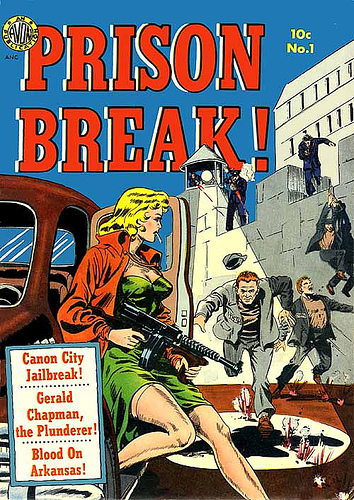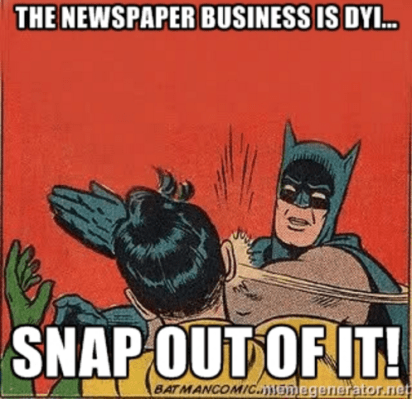The Newspaper Association of America’s annual MediaXchange conference is this weekend. And while I won’t be at this year’s event, I’ve been a “member”, attendee and sponsor in the past, and will attend again in the future.
Like the 17th iteration of Groundhog Day, sessions will focus on digital issues newspapers continue to face. (Advice: if you want to live, don’t play a drinking game at MediaXchange where the sip trigger is someone saying “In the new digital world…” It was the “new world” 20 yearsago. Now it’s just the world.)
By now we all know the problem. U.S. newspapers are losing a billion dollars in revenue a year. Many have gone out of business and those that remain have 40% smaller staffs than they did in 1989.

But get this: newspapers actually have the advantage now
The most frustrating part of newspapers’ downward spiral is that it’s happening while they have the greatest competitive advantage in the crowded “new digital world.” (Drink.) In our cluttered digital landscape consumers are less trusting and more cynical than ever before, making strong brands hard to build and harder still to sustain. Digital native publishers would kill to have the brand awareness and trust that newspapers have cultivated over decades. Even if they’ve cancelled their subscription, people still have an attachment to their local newspaper that the Huffington Posts of the world can’t replicate.
The idea of newspaper brand trust isn’t all that novel and won’t be overlooked at MediaXchange.
According to David Chavern, NAA’s new CEO: “Legacy newspapers actually have a huge advantage [because] if you have high-value branded content with growing engagement by valued consumers, then your ad inventory is both scarce and valuable.”
The problem, which I think newspapers would be the first admit, is that they have barely begun to leverage this advantage.
No solution inside the echo chamber
Trust is everything if you want to make money. Blue chip brands only work with and pay premiums to trusted blue chip content creators.
MediaXchange will again look to leverage that big “S” in their SWOT discussions (they won’t call it SWOT because that’s lame but they’ll have the discussion). Unfortunately, what will then ensue is a massive ad-tech and social media echo chamber — copied, pasted, repackaged amalgams of the same intransigent formulas from a playbook that’s been dusted off, recycled and sold for more than it was initially worth.
This dynamic isn’t happening because of industry or management incompetence. I’ve worked with hundreds of newspapers and they are an incredibly smart group. So why are newspapers failing to right the ship? It can be boiled down to two problems.
- Someone didn’t just move their cheese – the thief put it on a Mars Rover, launched it to another planet and buried it Jimmy Hoffa-style. This is an EXTREMELY difficult challenge.
- The industry has lost its self-esteem. Stop it, I’m being serious. Talking with many of them, they can occasionally sound like they’re a part of a systemic deer that’s caught in the headlights.
Pew Research Center’s Project for Excellence in Journalism did a study not too long ago called The Search for a New Business Model. In exchange for anonymity, newspaper executives gave startlingly candid commentary.
More than three-quarters said their single biggest challenge was their newspaper’s internal culture. One said, “You can change CEOs, executive VPs, digital VPs. You can wave this magic wand all you want. But at the end of the day, the troops in the field hunker down.”

After years of being pitched seven-minute-ab ideas from the young smooth talking “new media” and reading how bad things are, who wouldn’t lose some mojo and freeze a bit?
I’d like to hear more ideas that are completely new models for newspapers rather than attempts to better optimize what they’re already doing. For instance:
Idea 1: Be the digital commerce destination for your community
There is tons of competition in flash sales, daily deals, subscription fashion boxes and other e-commerce plays. All the funding in the space has resulted in robust API’s and players with the resources to create interesting partnerships. Sites like Shopify, Zulily and Gilt should be jumping at the opportunity to partner with newspapers.
Conversion rates are directly proportional to consumer’s level of trust. According to Pew Research, customers terminate 70% of online purchases because of a lack of trust. If only there was an industry group with 100+ years of built-in brand equity!
Mobile proliferation works in newspapers’ favor too. Mobile commerce is growing nearly 3 times faster than all other e-commerce. 50% of all mobile searches are conducted in hopes of finding local results, and 61% of those searches result in some sort of purchase. (Search Engine Watch). According to NAA, half of the 180 million unique newspaper visitors use a mobile device exclusively. Hmmm….
Don’t do this halfway though…
Dipping their toes in e-commerce isn’t a completely foreign idea to newspapers. Okanjo, a start-up that allows for Facebook style “Buy-it-now” buttons in ads, was selected as a winner in NAA’s Accelerator Pitch program in 2015. While a good start, this is still following the leader. “Facebook is doing what? Can we do that?”
Giving readers the ability to purchase a half second after seeing an ad has been around for years. Buy-it-now buttons inside ad real estate provides a more storefront feel, giving newspapers the hope that they can capture more of the shared economics of a purchase. But effective RPM (Revenue per thousand impressions) data proves that it’s nothing more than ads repackaged with some interactivity. The pitch is appealing but at the end of the day all it will do is shift business to a different ad-tech startup, only marginally improving ad revenue for newspapers.
Ideas like this are still “inside-the-box” thinking. Not metaphorically, I mean literally inside the same div or iframe ad-box where newspapers currently mine the majority of their insufficient digital revenue.

Remember, their cheese was moved to Mars; looking under the seat cushion in the living room isn’t going to uncover a transformative revenue stream.
It needs to be deeper. With the right partnerships digital papers can be a destination. They don’t need to be just another distribution channel for e-commerce companies.
Consumers have to be nurtured through each part of the buying funnel and be made aware that newspapers are now their trusted source to for products and deals. Inform your users (over and over) that you are supporting your community by finding and partnering with the best deals and products, with the best service, from the best companies. You’re opening a Seattle Times store!
Instead of hoping your users buy a hoverboard while they’re reading about city council initiatives, you’ll have branded yourself has a place to go for deals and potentially even general online shopping down the road. You should even have a separate Curated Deals app.
Then you’re not just catching up to Facebook, you’re leveraging an asset Facebook doesn’t have.
Facebook’s only similar market option is relying on its users to market products to their friends. They can’t be a trusted commerce brand because they lack that whole, you know, trust part.
Idea 2: Take on changing demographics more aggressively
Fewer than 20% of people ages 25-34 read the newspaper daily, down from 41% in 2003. Incredibly though – defying the laws of everything – while newspapers are in a freefall, applications to journalism schools are skyrocketing. This will leave millions of writers so starved to be printed that they’ll likely give their content away to Demand Media. Wait, this is already happening.
Who do you think young journalists who speak millennia would rather have on their resume – Demand Media or the Los Angeles Times?
You don’t even have to wait until they graduate and need to make a real salary. Give them beat gigs and brand them “Ground Troops.” It will be a prestigious position. And don’t take applications: organize a contest where you select a few for each section of your paper.

These ground troopers will be writing with nothing to lose, and everything to gain from making a splash.
If you pick the right ones, they’ll bring the millennials to you. Millennials who buy things and influence others.
They’ll also bring a contagious new energy and challenge the old guard to step up. Growing up, every time our family dog would get old we’d buy a puppy. Guess what? Damn it if that old dog didn’t get a second wind! He sure did. What I’m saying is, buy your family a new pup. He’ll be annoying and you’ll have to potty train him but he’ll also be amazing.
Give them podcast and videocast platforms too. The number of annual podcast downloads is over 3 billion now and growing by more than 50% per year. You don’t have to create the next Serial. These are low risk, high return investments, so throw a bunch of them on the wall and see what sticks. The only reason newspaper content has been exclusively article-based the last 100 years is because delivering tape recorders on subscriber’s lawns every morning wasn’t a cost effective distribution strategy.
Idea 3: Evolve your governing body
According to intense research I did scanning headshots on the NAA’s Board of Directors webpage they don’t have one member under the age of 45. As boards go, this is common and generally there’s nothing wrong with it. But if attracting youth is your greatest problem this seems like low hanging fruit. I would go so far as to elect 2-3 university student representatives on a rolling basis.
The NAA should allow all journalism schools accredited by the ACEJMC to elect a student representative to attend MediaXchange for free each year. That’s fewer than 150 students. Allow them all to apply to be on a new student panel at MediaXchange as well.
The board should have every director pick an exhibitor they’ve never met to have coffee or a beer with at MediaXchange. You can call it “Spicoli meets Mr. Hand” (working title). Those exhibitors are the people trying to solve newspaper problems. 90% of them are digital monetization and engagement people, right? Sounds like a good opportunity to me. The NAA board members could hold an internal draft every year to decide who gets to meet with which each exhibitor.
Closing thoughts
Newspapers will never enjoy an oligopoly again. We live in a world where the series finales of Breaking Bad, Mad Men and The Office combined had fewer viewers than the series finale of Alf. As Chris Rock says, “people are only as faithful as their options.” Consumers are still into you, newspapers, but big, sweeping changes have to happen now.
Newspapers are reaching a critical point. Their brands are on the precipice of significant value and opportunity loss. When the tail-end of the millennials who don’t have fond memories of their parents reading the paper enter their 30’s and control the most coveted brand demographic, it will be over.
Nobody has a stopwatch on exactly when that will happen but I do know the needle needs to start moving faster now.
